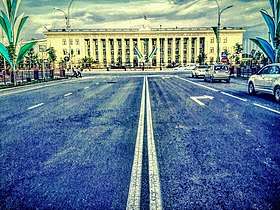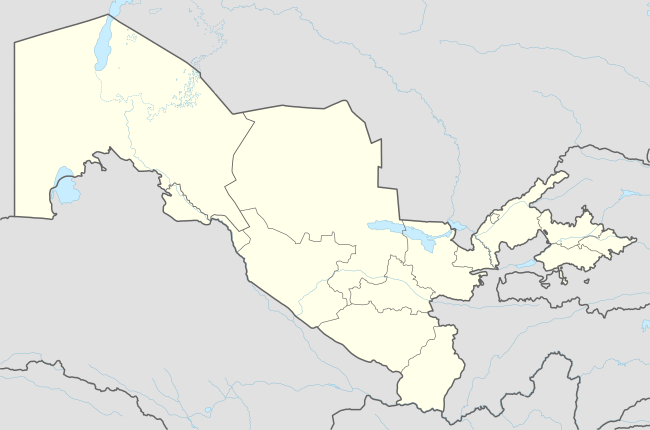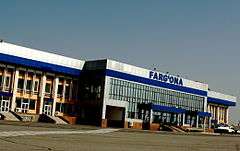Fergana
Fergana (Uzbek: Fargʻona/Фарғона, فەرغانە; Tajik: Фарғона, Farğona/Farƣona; Persian: فرغانه Farġāna/Farqâna; Russian: Фергана́), or Ferghana, is the capital of Fergana Region in eastern Uzbekistan. Fergana is about 420 km east of Tashkent, about 75 km west of Andijan, and less than 20 km from the Kyrgyzstan border.
Fergana Fargʻona / Фарғона | |
|---|---|
      | |
 Fergana Location in Uzbekistan | |
| Coordinates: 40°23′11″N 71°47′11″E | |
| Country | |
| Region | Fergana Region |
| Established | 1876 |
| Government | |
| • Type | City Administration |
| Area | |
| • Total | 95.6 km2 (36.9 sq mi) |
| Elevation | 590 m (1,940 ft) |
| Population (2014) | |
| • Total | 264,900 |
| • Density | 2,800/km2 (7,200/sq mi) |
| Area code(s) | (+998) 73 |
| Website | ferghana |
While the area has been populated for thousands of years, the modern city was founded in 1876.
History

The city of Fergana was founded in 1876 as a garrison town and colonial appendage to Margelan (22 kilometres or 13 1⁄2 miles to the northwest) by the Russian Empire. It was initially named New Margelan (Новый Маргелан), then renamed Skobelev (Скобелев) in 1907 after the first Russian military governor of Fergana Valley. In 1924, after the Bolshevik reconquest of the region from basmachi rebels, the name was changed to Fergana, after the province of which it was the centre.[1]
The industrial base of Fergana was developed in the 20th century. Industry in the city included textile manufacturing and a nitric fertiliser plant. Some of the industrial development was a result of Evacuation in the Soviet Union during World War II.[2]

Fergana has been a center for oil production in the Fergana Valley since the region's first oil refinery was built near the city in 1908. Since then, more refineries have been added, and Fergana is one of the most important centers of oil refining in Uzbekistan. Natural gas from western Uzbekistan is transported by pipeline to the valley, where it is used to manufacture fertilizer. The Great Fergana Canal, built almost entirely by hand during the 1930s, passes through the northern part of the city and was completed in 1939. During its construction, the canal and the city were widely photographed by the noted photographer Max Penson. With a western loan Fergana is able to modernize its refinery and also reduce air pollution[3] emissions.
Climate
Fergana has a cold desert climate (Köppen climate classification BWk). Winters are cool and short, with a daily average low temperature of −2.8 °C (27 °F) and a daily average high of 4.6 °C (40 °F) in January; summers are hot, with an average low temperature of 20.3 °C (69 °F) and an average high of 34.7 °C (94 °F) in July. Annual precipitation is less than 200mm, and is higher in winter and autumn.
| Climate data for Fergana (1981–2010, extremes 1881–present) | |||||||||||||
|---|---|---|---|---|---|---|---|---|---|---|---|---|---|
| Month | Jan | Feb | Mar | Apr | May | Jun | Jul | Aug | Sep | Oct | Nov | Dec | Year |
| Record high °C (°F) | 16.3 (61.3) |
23.1 (73.6) |
29.0 (84.2) |
34.4 (93.9) |
39.2 (102.6) |
41.3 (106.3) |
42.2 (108.0) |
41.4 (106.5) |
37.1 (98.8) |
32.6 (90.7) |
29.0 (84.2) |
17.6 (63.7) |
42.2 (108.0) |
| Average high °C (°F) | 4.6 (40.3) |
7.6 (45.7) |
14.7 (58.5) |
22.3 (72.1) |
27.6 (81.7) |
33.1 (91.6) |
34.7 (94.5) |
33.6 (92.5) |
28.8 (83.8) |
21.2 (70.2) |
13.4 (56.1) |
6.2 (43.2) |
20.7 (69.3) |
| Daily mean °C (°F) | 0.3 (32.5) |
2.9 (37.2) |
9.3 (48.7) |
16.0 (60.8) |
20.9 (69.6) |
25.7 (78.3) |
27.4 (81.3) |
25.8 (78.4) |
20.7 (69.3) |
13.8 (56.8) |
7.4 (45.3) |
1.7 (35.1) |
14.3 (57.7) |
| Average low °C (°F) | −2.8 (27.0) |
−0.6 (30.9) |
4.9 (40.8) |
10.5 (50.9) |
14.6 (58.3) |
18.5 (65.3) |
20.3 (68.5) |
18.7 (65.7) |
13.7 (56.7) |
8.0 (46.4) |
3.2 (37.8) |
−1.2 (29.8) |
9.0 (48.2) |
| Record low °C (°F) | −25.8 (−14.4) |
−25.5 (−13.9) |
−17.9 (−0.2) |
−4.8 (23.4) |
1.2 (34.2) |
7.4 (45.3) |
10.1 (50.2) |
7.8 (46.0) |
0.5 (32.9) |
−7.4 (18.7) |
−22.8 (−9.0) |
−27.0 (−16.6) |
−27.0 (−16.6) |
| Average precipitation mm (inches) | 18.3 (0.72) |
20.7 (0.81) |
25.4 (1.00) |
22.8 (0.90) |
21.7 (0.85) |
11.1 (0.44) |
5.3 (0.21) |
3.1 (0.12) |
6.0 (0.24) |
16.7 (0.66) |
18.0 (0.71) |
24.2 (0.95) |
193.3 (7.61) |
| Average precipitation days | 9 | 10 | 10 | 11 | 13 | 10 | 8 | 5 | 4 | 6 | 7 | 9 | 102 |
| Average rainy days | 4 | 7 | 10 | 10 | 13 | 10 | 8 | 5 | 4 | 6 | 7 | 6 | 90 |
| Average snowy days | 7 | 5 | 1 | 0.1 | 0 | 0 | 0 | 0 | 0 | 0.3 | 1 | 5 | 19 |
| Average relative humidity (%) | 81 | 76 | 67 | 61 | 56 | 48 | 48 | 52 | 56 | 66 | 74 | 82 | 64 |
| Mean monthly sunshine hours | 106 | 109 | 153 | 205 | 276 | 337 | 362 | 345 | 292 | 218 | 150 | 95 | 2,648 |
| Source 1: Centre of Hydrometeorological Service of Uzbekistan[4] | |||||||||||||
| Source 2: Pogoda.ru.net (mean temperatures/humidity/rainy and snow days 1981–2010, record low and record high temperatures),[5] NOAA (sun only, 1961–1990)[6] | |||||||||||||
Demographics
The population of Fergana was approximately 227,000 as of January 2007. Tajiks and Uzbeks are the largest ethnic groups, with Russian-speakers comprising about 25% of the city's population.[2]
Culture
Architecture
Fergana has a high proportion of Russian, Soviet Koreans and Tatar inhabitants compared to other Fergana Valley cities. With its wide, tree-lined boulevards and Tsarist-era buildings, and Russian spoken frequently on the streets, the city has a distinctly different feel from the rest of the region.[7]
 Temple
Temple- Chapel
 City center
City center River
River
Main sights
- Museum of Local Studies – with displays of natural history, photographs, and local handicrafts
- Regional Theatre – in 1877 the house of General Mikhail “Old Bloody Eyes” Skobelev
- Fergana State University - built in 1902
Notable residents
- Shamshad Abdullaev – author, poet
- Xudoyberdi To'xtaboyev – author
Sports clubs
- FC Neftchi Fergana
- FK Istiqlol Fergana
See also
- Babur
- FK Neftchy Fargʻona
- Nurkhon Yuldasheva
References
- Hill, John E. (2009) Through the Jade Gate to Rome: A Study of the Silk Routes during the Later Han Dynasty, 1st to 2nd Centuries CE. John E. Hill. BookSurge, Charleston, South Carolina. ISBN 978-1-4392-2134-1.
- Watson, Burton. Trans. 1993. Records of the Grand Historian of China: Han Dynasty II. Translated from the Shiji of Sima Qian. Chapter 123: "The Account of Dayuan," Columbia University Press. Revised Edition. ISBN 0-231-08166-9; ISBN 0-231-08167-7 (pbk.)
- Jean-Marie Thiébaud, Personnages marquants d'Asie centrale, du Turkestan et de l'Ouzbékistan, Paris, L'Harmattan, 2004. ISBN 2-7475-7017-7.
Notes
- Dates of renaming taken from Adrian Room, Placenames of the World: Origins and Meanings of the Names for Over 5000 Natural Features, Countries, Capitals, Territories, Cities and Historical Sites, McFarland, 1997, ISBN 0-7864-1814-1 (pbk) p.124
- Flynn, Moya; Kosmarskaya, Natalya; Sabirova, Guzel (November 2014). "The Place of Memory in Understanding Urban Change in Central Asia: The Cities of Bishkek and Ferghana". Europe-Asia Studies. 66 (9).
- Uzbekistan's Fergana Refinery is upgraded with EBRD finance 1997 Archived 2007-12-13 at the Wayback Machine
- "Average monthly data about air temperature and precipitation in 13 regional centers of the Republic of Uzbekistan over period from 1981 to 2010". Centre of Hydrometeorological Service of the Republic of Uzbekistan (Uzhydromet). Archived from the original on 15 December 2019. Retrieved 15 December 2019.
- "Weather and Climate – The Climate of Fergana" (in Russian). Weather and Climate (Погода и климат). Archived from the original on 6 December 2016. Retrieved 15 December 2019.
- "Climate Normals for Fergana". National Oceanic and Atmospheric Administration. Retrieved 31 January 2013.
- "Fergana travel guide". Caravanistan. Retrieved 2019-09-26.